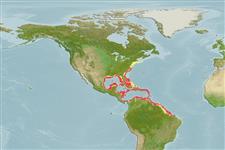>
Eupercaria/misc (Various families in series Eupercaria) >
Lutjanidae (Snappers) > Lutjaninae
Etymology: Lutjanus: Malay, ikan lutjan, name of a fish.
More on author: Cuvier.
Environment: milieu / climate zone / Tiefenbereich / distribution range
Ökologie
seewasser riff-verbunden; tiefenbereich 20 - 200 m (Ref. 9626), usually 80 - 150 m (Ref. 55). Subtropical; 43°N - 3°S, 100°W - 38°W (Ref. 55227)
Western Atlantic: as far north as North Carolina, USA and Bermuda south to Trinidad and northern Brazil; including the Gulf of Mexico (Ref. 9626). Very common in the Caribbean, particularly the Antilles.
Length at first maturity / Size / Gewicht / Alter
Geschlechtsreife: Lm 28.7, range 21 - 25 cm
Max length : 75.0 cm TL Männchen/unbestimmt; (Ref. 9710); common length : 50.0 cm TL Männchen/unbestimmt; (Ref. 55); max. veröff. Gewicht: 14.0 kg (Ref. 9710)
Rückenflossenstacheln (insgesamt) : 10; Rückenflossenweichstrahlen (insgesamt) : 14; Afterflossenstacheln: 3; Afterflossenweichstrahlen: 8. Preopercular notch and knob weak. Scale rows on back rising obliquely above lateral line. Mainly scarlet red, silvery on lower sides and belly; fins are yellowish to orange. A prominent black blotch is at the base and in axil of pectoral fins.
Body shape (shape guide): fusiform / normal; Cross section: oval.
Adults inhabit deeper waters over sandy or rocky bottoms and near drop-offs and ledges. Young occur in shallower water, often between about 35 and 50 m. Feed mainly on fishes. Good food fish, it is marketed mostly fresh (Ref. 55).
Allen, G.R., 1985. FAO Species Catalogue. Vol. 6. Snappers of the world. An annotated and illustrated catalogue of lutjanid species known to date. FAO Fish. Synop. 125(6):208 p. Rome: FAO. (Ref. 55)
IUCN Rote Liste Status (Ref. 130435: Version 2025-1)
Bedrohung für Menschen
Reports of ciguatera poisoning (Ref. 55)
Nutzung durch Menschen
Fischereien: kommerziell; Sportfisch: ja
Tools
Zusatzinformationen
Download XML
Internet Quellen
Estimates based on models
Preferred temperature (Ref.
123201): 18 - 26.2, mean 22.3 °C (based on 64 cells).
Phylogenetic diversity index (Ref.
82804): PD
50 = 0.5000 [Uniqueness, from 0.5 = low to 2.0 = high].
Bayesian length-weight: a=0.01479 (0.01312 - 0.01668), b=2.97 (2.95 - 2.99), in cm total length, based on LWR estimates for this species (Ref.
93245).
Trophic level (Ref.
69278): 3.9 ±0.57 se; based on food items.
Widerstandsfähigkeit (Ref.
120179): mittel, Verdopplung der Population dauert 1,4 - 4,4 Jahre. (K=0.10-0.70).
Fishing Vulnerability (Ref.
59153): High vulnerability (62 of 100).
🛈
Nutrients (Ref.
124155): Calcium = 17.7 [9.4, 27.6] mg/100g; Iron = 0.317 [0.183, 0.541] mg/100g; Protein = 19.3 [17.8, 20.7] %; Omega3 = 0.214 [0.132, 0.353] g/100g; Selenium = 40.5 [22.1, 74.1] μg/100g; VitaminA = 56.3 [10.1, 268.9] μg/100g; Zinc = 0.248 [0.178, 0.379] mg/100g (wet weight);
